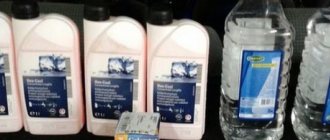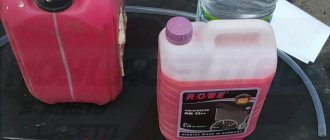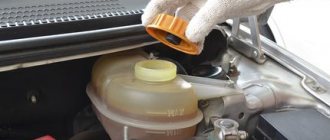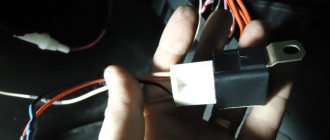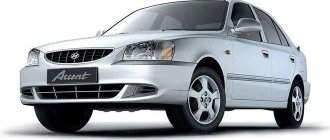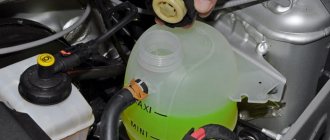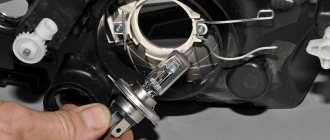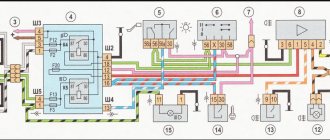02/27/2022 8 213 Coolant
Author: Victor
Antifreeze is one of the main consumables in any car. The refrigerant is designed to cool the power unit, which helps prevent it from overheating. How to replace Lanos antifreeze, what fluid to fill and how to check its level - you will find here.
[Hide]
How to replace coolant on a Chevrolet Lanos
From time to time, almost all car owners think about the condition of the antifreeze and whether it is time to replace it. Let us immediately note that this is an extremely important issue in car service.
Important! According to the manufacturer's instructions, only antifreeze based on ethylene glycol should be poured into the Chevrolet Lanos cooling system. Under no circumstances should you use antifreeze, much less water.
The cooler must be replaced if the car has been in use for more than four years or the mileage has exceeded 40 thousand kilometers.
Replacement can be made earlier if you notice that the color of the antifreeze has darkened or acquired a brown tint. This is an obvious sign that it needs to be replaced urgently.
For Chevrolet Lanos, according to the instructions, the volume is seven liters. However, according to the experience of many car enthusiasts, five will be enough. The design of the Chevrolet Lanos cooling system is designed in such a way that the entire volume of antifreeze cannot be drained.
What to fill
When Lanos antifreeze is replaced, a big role is played by what type of liquid will be poured into the car. Today, the range of fluids for the cooling system is very diverse. It is best to fill in exactly the fluid that the manufacturer himself fills in and recommends; this information can be found in the service book; if you use the original fluid, you can completely do without flushing the system. If you cannot purchase the liquid recommended by the manufacturer, then you should contact special websites or consultants in the store, so you can choose a good analogue.
How to change coolant
Antifreeze should be replaced after the engine has completely cooled down. It is also important that the car is installed on a relatively level area.
How to drain
- We twist the drain plug, it is located on the left of the radiator.
Location of the drain plug Having previously placed a previously prepared container for draining the waste liquid, unscrew the tank plug.
Expansion tank plug
- Since there is no plug for draining the liquid on the Chevrolet Lanos, for reasons known only to its developers, it will not be possible to drain the coolant completely.
- However, you can try to drain as much liquid as possible. To do this, you need to jack up the rear or front right wheel of the car. This simple procedure will help drain a little more coolant from the engine.
- Sometimes the tank becomes clogged and needs to be removed and washed with water.
How to fill
- After all previous operations have been completed, pour new coolant into the tank until its level reaches the MAX mark on the expansion tank. We start the engine and wait for the fan to work.
- To better fill the system with liquid and to prevent air locks from forming, be sure to squeeze the radiator pipes with your hands while filling.
- Turn off the engine. Check the antifreeze level in the tank.
- If necessary, add coolant until it reaches the “MAX” mark.
How to pre-flush a car's cooling system
Before replacing antifreeze on Lanos, Sense and Chance, it is necessary to flush the system. This procedure is not at all mandatory, but it is recommended in the following situations:
The primary rinsing process involves performing the following manipulations:
After the engine has been running for 10-15 minutes, you can turn it off and begin draining and replacing the refrigerant. How to replace antifreeze on Chevrolet and Daewoo Lanos, we will consider in detail below.
Stages of replacing coolant in a Chevrolet Lanos
Replacing the coolant is divided into several stages; in addition to the main ones, which include draining and filling, it is recommended to flush the system. Since it is not possible to completely drain the old antifreeze from the system.
This model was produced in different countries under different car brands, as well as with different model names and minor design differences. Therefore, the replacement instructions will be applicable for the following varieties:
- Chevrolet Lanos;
- Daewoo Lanos;
- Daewoo Sens;
- FSO Lanos (FSO Lanos);
- ZAZ Lanos;
- ZAZ Sens;
- ZAZ Chance;
- Doninvest Assol.
The most popular is the 1.5 liter petrol engine. But you can also find cars with 1.6, 1.4, 1.3 liter engines installed, also running on gasoline.
Coolant drain
To accurately drain coolant from a Chevrolet Lanos, it is better to perform work in a pit or overpass. This will make it easier to remove the engine protection so that the drained antifreeze does not splash around, but flows smoothly into the container.
If there is no hole and you are not very worried about the fact that the protection will be in traces of smudges, then you can reach the drain plug from the engine compartment. Therefore, we put the car on a flat surface, wait for the engine to cool down and start draining:
- We find the drain plug, unscrew it, after placing a container under it (Fig. 1). The drain hole is located on the left side, at the bottom of the radiator, when viewed from the pit. Accordingly, if you stand facing the car and do everything from the engine compartment, the traffic jam will be on the right.
Fig. 1 Drain plug As soon as the antifreeze has flowed, you can unscrew the filler cap on the expansion tank. Thereby increasing the flow of drained liquid (Fig. 2).
Fig. 2 Expansion tank cap It would not be superfluous to remove the hose from the heating of the throttle assembly and blow it out, another small part will drain out (Fig. 3).
Fig. 3 Throttle assembly hose It is also recommended to remove the expansion tank for flushing; sediment often accumulates at the bottom, and the walls become overgrown with plaque (Fig. 4). It is easy to remove, just unscrew 2 nuts and disconnect the fittings that go to it.
Fig.4 Mounting the tank
Unfortunately, it will not be possible to drain antifreeze from the block on a Chevrolet Lanos with a popular 1.5 liter engine; it does not have a drain hole. Therefore, about 2 liters of old fluid remains in the cooling system.
By following these instructions, you can drain the antifreeze as completely as possible. It is recommended to remove old residue by rinsing with distilled water.
Flushing the cooling system
Flushing with distilled water is necessary to completely remove old antifreeze, as well as to flush out deposits in the cooling system. Without performing this procedure, the properties and service life of the new liquid being poured may deteriorate.
To perform this operation, it is necessary to close the drain valve and put the expansion tank in place. After this, you can pour distilled water into it until it comes out of the removed hose going to the throttle assembly. This is necessary to allow air to escape from the system.
Next, put the hose in place and add water to the middle of the tank. We start the engine and wait until it warms up to operating temperature. After reaching temperature, the thermostat will open and water will flow through a large circle of the cooling system.
That's it, the liquid has passed through the entire system, now you can turn off the engine, wait until it cools down and drain it. We repeat this operation several times until the drained water is clear.
Usually, to achieve a good result, 4-5 repetitions of this simple operation are enough. But some motorists describe having to wash it 8 or even 10 times.
Filling without air pockets
The flushed system is completely ready for filling with new antifreeze. But since it is impossible to drain completely distilled water from the Chevrolet Lanos system, it is best to use a concentrate as a new fluid. It can be diluted, taking into account the remaining residue.
Replacement frequency, what antifreeze to fill
According to the regulations, the recommended maintenance for replacing the coolant is specified by the manufacturer to be performed once every 4 years or after 40,000 kilometers. As for subsequent replacements, you need to be guided by the information on the canister of the product being poured.
The best choice for filling as a new fluid would be to use the original General Motors Dex-Cool Longlife product. It is produced in the form of a concentrate and has the following articles and order codes: 93170402 (1 l.), 93742646 (2 l.), 93742647 (2 l.).
In addition to the original product, you can purchase its complete analogues, Havoline XLC or Coolstream Premium. The latter, by the way, went to a plant located near St. Petersburg and was used as the first fill.
You can go the other way and look for antifreezes that meet the approval that the automaker requires for use in Chevrolet Lanos. One of these is Kroon Oil Antifreeze SP 12. Many car enthusiasts highlight its quality properties, as well as its long service life.
How much antifreeze is in the cooling system, volume table
| Model | Engine capacity | How many liters of antifreeze are in the system | Original liquid / analogues |
| Chevrolet Lanos | gasoline 1.6 | 7.0 | Genuine General Motors Dex-Cool Longlife |
| gasoline 1.5 | Havoline XLC | ||
| gasoline 1.4 | Coolstream Premium | ||
| gasoline 1.3 | Kroon Oil Antifreeze SP 12 |
How to find out what is in the cooling system of a car
Replacing antifreeze in a Chevrolet Lanos 1.5 is not a complicated procedure, but it is much more difficult to choose the appropriate coolant that will ensure efficient engine operation (meaning, it will ensure quick warming up of the engine in winter and cooling it in summer). Which coolant is best to fill into a car is described in detail in this material. Today we will learn how to determine what kind of coolant is poured into the cooling system of Lanos, Sense and Chance cars, how to determine the need for replacement, and also how to replace antifreeze with your own hands.
If you forgot or bought a car, but did not find out from the previous owner what type of refrigerant he used, then you can find out on your own. Two types of refrigerants are used as coolants - antifreeze and antifreeze. To find out what type of coolant is filled, you need to pay attention to the following factors:
Antifreeze, which was produced back in the 70s under the USSR, differed from modern analogues in its high quality. In addition to its resistance to boiling and crystallization, the antifreeze changed its color as the amount of additives was reduced. When the blue liquid became colorless, it meant it needed to be replaced. The production of high-quality antifreeze continued until the 90s, after which production was curtailed and closed. However, liquids with the name “Antifreeze” continued to be produced, but only at various enterprises in the Russian Federation.
Modern antifreeze manufacturers make it using inorganic compounds and other substances that do not meet standards. This leads to the fact that the liquids work for no more than 2 years, and have a low boiling point (up to 110 degrees). Based on the current historical situation with antifreeze, today many motorists prefer to use foreign analogues, which cannot be called wrong. Using one of the above methods, you can understand what exactly is poured into the Lanos cooling system.
Leaks and problems
Problems with the cooling system in Lanos are typical for most cars. From time to time it is necessary to change the thermostat and pump. Sometimes, over time, the expansion tank begins to leak.
Antifreeze leaks from the pipes occur due to their wear, as well as due to failed clamps. Leaks can also occur from excess pressure in the system, due to the failure of the bypass valve located in the expansion tank plug. Therefore, it is recommended to change the cover periodically.
Video “Visual instructions for flushing the cooling system”
Find out how to properly flush the cooling system in a Chevrolet Lanos and what needs to be taken into account from the visual instructions in the video (the material was filmed and published by Evgeniy Trushanin).
Do you have any questions? Specialists and readers of the AUTODVIG website will help you ask a question
Was this article helpful?
Thank you for your opinion!
The article was useful. Please share the information with your friends.
Yes (100.00%)
No
X
Please write what is wrong and leave recommendations on the article
Cancel reply
Rate this article: ( 6 votes, average: 5.00 out of 5)
Discuss the article:
How to choose and replace antifreeze on a Chevrolet Lanos: step-by-step instructions
Replacing coolant on a Chevrolet Lanos
And you need to decide on the brand in order to buy high-quality coolant. If, after a certain period of time, the antifreeze you poured in loses color, for example, a fairly common case turns brown, then you can be congratulated on purchasing a fake antifreeze. I loosened the clamp, removed the pipe from the pump, and it drained.
Millions of car owners choose SINTEC quality.
But for this you will have to acquire a special hydrometer. Next we will flush the cooling system. It turns out that everything is like in a pharmacy:
It is written that the bottle is designed for liters. From personal experience, drivers have verified that it only costs 5 liters to buy a fluid change in Lanos. In the next article we will tell you how to change antifreeze on a Mitsubishi.
Sometimes there are problems with coolant leaks in the car model in question. The antifreeze level is below the permissible level. Air lock when filling.
Loose hose fastenings. However, there may be completely different problems. After putting everything back together, before putting it on, you can lightly coat the inside of the hoses with lithol.
Where does the antifreeze go? Daewoo Lanos 1.5 cylinder head repair.
I filled it with water, warmed it up, and just drained the yellowish cloudy stuff from the radiator. I filled it with water again along with this thing: It says that the bottle is designed for liters.
I poured out half the bottle. I warmed it up, drove it for 30 minutes, and again drained everything I could after removing the hoses.
I filled it with water again, warmed it up, and drained it. Based on the operating instructions for a Chevrolet Lanos car, you should fill it with a liquid based on ethylene glycol.
It is recommended to listen to the manufacturer’s recommendations and not to add other liquids, including water, into the system. When to change Already at 40 km, the antifreeze will look like this.
But another important point is when to change the fluid in the system. I’ll explain why exactly five liters.
Due to the design features of the Daewoo Lanos car engine, which does not have a drain plug on the block, it will not be possible to completely drain the antifreeze!
With all the tricks discussed below, coolant remains in the engine block. So, there is no point in taking the full amount of antifreeze.
I will not recommend a brand of antifreeze, since the choice in markets and stores is very large and no one will insure you against buying a counterfeit with a sticker of the recommended brand. If you have acquaintances or friends at a car market or auto shop, you can consult with them. If not, please show quality certificates of the goods being sold.
Replacing antifreeze on Lanos
It is not always possible to get to a car service center to quickly replace the coolant. As autumn approaches, many drivers begin to think about the condition of their cooling system.
They ask themselves whether the fluid in their car needs to be changed and what exactly needs to be put into the system? But not many car enthusiasts know how to do this correctly in a Daewoo Lanos car? This article will try to give a complete answer to this question.
Let us remind you that the same car is also called Chevrolet Lanos (Chevrolet Lanos)
Is it possible to do it yourself
Of course, you can replace the coolant yourself if you have certain knowledge and skills. Let's start by deciding on the type of coolant. If you follow the manufacturer's instructions, the recommended fluid is antifreeze. Therefore, let's try to follow the instructions to the letter and add antifreeze. Regarding antifreeze, we will briefly describe its disadvantages below.
Antifreeze, like antifreeze, serves to create a protective layer on the metal surface, actually protecting the engine from corrosion.
But, due to its parameters, antifreeze worsens heat transfer, which increases the load on the engine, fuel consumption and affects the drop in power.
Whereas, antifreeze increases the cooling efficiency of the engine by selectively forming a protective layer, i.e., only where corrosion occurs.
When to start replacement
The manufacturer states that the fluid must be replaced after 4 years of using the car, as well as in case of low density or unnatural color of the antifreeze.
Of course, to determine the density you need special equipment, in particular a hydrometer. Whereas, you can determine the color of the coolant yourself.
Colorless or brown liquid indicates that it needs to be replaced.
Chevrolet Lanos 2008, 86 l. With. — self-repair
After we have decided on the volume and brand of antifreeze, we check the availability of the necessary tools to replace antifreeze in a Daewoo Lanos car. This is necessary if you decide to use a different brand of antifreeze, or if the used liquid is heavily contaminated.
We turn on the drain valve on the radiator and pour water into the expansion tank until it begins to flow out of the throttle body hose, which we have removed. Next, tighten the plug, put on the hose and start the engine.
Replacing coolant (antifreeze) in a Daewoo Lanos car (Daewoo Lanos)
After a few minutes of operation, turn it off and drain the water. We repeat these steps several times; clean water should flow out of the cooling system. The expansion tank may also be dirty.
Use pliers to disconnect the three pipes from the tank and unscrew the two nuts with a socket wrench on
Why might antifreeze leak?
Briefly about the reasons why a coolant leak may occur:
- Leakage can be confused with a decrease in the volume of consumables; this always happens in winter. During the cold season at sub-zero temperatures, the refrigerant in the expansion tank loses a little volume.
- The appearance of cracks and other damage on the tank. Detecting these defects, especially if they are minor, is not so easy. Sometimes they are not visible and look like scratches. Minor damage can be repaired by cold welding. If the cracks are serious, then the expansion tank must be replaced.
- The connections of the cooling system pipes have become depressurized. This is often due to loose clamps. These elements need to be tightened or replaced.
- Damage to hoses and pipes. They wear out as a result of long-term use or mixing of different types of antifreeze. The simultaneous use of coolants of different compositions can lead to a chemical reaction that has an aggressive effect on the rubber elements of the system - pipes and hoses. Damaged lines must be replaced.
- The thermostat gasket is worn out. Usually, when the gasket wears out, the thermostat itself changes, since the service life of these elements is the same. It is advisable to change the thermostat.
- Malfunctions in the operation of the radiator device. If the radiator is leaking, you can try to repair it using cold or argon welding. But this rarely helps; usually the radiators are simply changed.
- The leak may be due to antifreeze getting into the engine oil. This problem is the most serious and occurs as a result of damage to the cylinder head gasket or the cylinder head itself. You will have to remove the head and carry out detailed diagnostics of the unit. A damaged gasket must be replaced.
What are the signs to identify a leak?
- while driving, smoke came out from under the hood of the Lanos;
- after starting the engine, white steam comes out of the car's exhaust pipe;
- the stove does not work well, does not heat, but only cools;
- an engine fault indicator appeared on the dashboard;
- the temperature sensor needle has risen to the maximum;
- the car interior smells of antifreeze due to a leak in the heater radiator;
- a puddle appeared under the front seat mat.
Daewoo Lanos 1.6 16V SX FSO › Logbook › Replacing antifreeze
Hi all!
Since the mileage is approaching 80 thousand km, it is time to replace the antifreeze. As you know, on our cars replacement is carried out every 40 thousand km or every 4 years, whichever comes first.
As always, I will provide visual instructions on what and how to do. The operation is not complicated, but time-consuming, it can take about 2-3 hours, if you do the washing, like I did. I would advise replacing antifreeze with flushing the cooling system.
Here's my replacement kit
:
-HEPU® P999-G12-005 - 5 liters of concentrate - 470 UAH; -Distilled water - 20 liters - 65 UAH.
I’ll say right away that you can safely take 30 liters of water.
The operation of replacing antifreeze is best carried out in a pit; I did it at a friend’s place on a lift, which is also convenient :)
We drain the old antifreeze on a cold engine. To do this, we are looking for a drain hole. As the car moves, it is located at the bottom left of the radiator, on the 1.6 engine. At 1.5 it’s possible on the other hand, I don’t know.
Prepare a container with a volume of at least 5-6 liters in advance. We unscrew the drain plug, then unscrew the plug of the expansion barrel, the old antifreeze is drained into the container that we placed underneath.
It’s good that the system was not rusty and the antifreeze was not cloudy. Antifreeze G11 was filled in.
When drained, the antifreeze spreads like this:
Thus, I lost no more than 4 liters. Go ahead. Remove the pipe from the throttle heating:
More liquid will drain out. You can also blow into the pipe that we removed from the throttle and blow into the expansion tank. This will drain approximately 5 liters. Some people jack up the rear right wheel. I didn't do this.
After everything has drained, we tighten the drain hole, do not attach the pipe to the throttle, but fill it with distilled water until water flows from the hoses, then install the pipe on the throttle and add water to the MAX level. To better fill the system without air locks, you need to periodically squeeze the radiator hoses by hand. This way the system will be minimally aired.
After this, without tightening the expansion tank cap, start the car for a couple of minutes, watch the water level, and also press the radiator pipes by hand.
After a couple of minutes, turn off the engine and repeat the procedure: -unscrew the drain plug and drain; -remove the pipe from the throttle; - blow with your mouth into the pipe and tank; -tighten the drain hole; -refill water until it flows from the throttle pipe; -attach the pipe to the throttle; -add to the MAX level;
After the first drain of the water, it came out almost the same color as the antifreeze. With each subsequent flush it became cleaner and cleaner. I did 4 such flushes of the system; more could have been done, but then there would not have been enough water to dilute the concentrate. Therefore, you can safely take 30 liters of water if you have a clean system. And if you have a contaminated system, then much more. I think after about 6 flushes, I would have drained clean water. During the last flush, I warmed up the engine until the fan turned on. After 4 washes we see water like this, green dye is still present, but it’s barely noticeable:
Although my expansion tank was not dirty, I still decided to wash it for my peace of mind. To do this, unscrew the 2 nuts securing the tank.
We also remove all the pipes:
We rinse the tank with clean water and install it and the pipes in place in the reverse order.
Based on the fact that Lanos has 7 liters of coolant in the system, and we drained about 5 liters, we believe that about 2 liters of water remain there (because we thoroughly washed the system with water several times), it is necessary to fill in 3.5 liters of concentrate
in a 1:1 ratio with water.
That is, pour 3.5 liters of concentrate and add about 1.5 liters of water. 2 liters + 3.5 liters + 1.5 liters = 7 liters.
And we get
antifreeze with a pour point of up to -37°C
.
When filling with concentrate, we also fill until it starts to flow from the throttle pipe, then we put it in place and top up, while squeezing the radiator pipes with our hands to better fill the system.
We start the car, leaving the tank cap open so that the air comes out and does not create excess pressure in the tank. With the engine running, we also press the radiator pipes by hand.
We warm up the engine before turning on the fan; after turning on the fan, you can turn on the stove and run it in different modes. We turn off the engine. If the level of antifreeze in the system has dropped, add it to the MAX level, but add water, since we have already filled in the required 3.5 liters of concentrate. We tighten the cap of the expansion tank.
At this point, the replacement of antifreeze can be considered complete.
After a few days of using the car, you should monitor the antifreeze level and, if necessary, add water. And also monitor whether the antifreeze changes its color to brown or becomes discolored. If this suddenly happens, it means that you bought a fake and it is better to replace this “liquid” immediately.
Of the 5 liters of antifreeze I purchased, I have exactly 1.5 left. This means that they can be diluted 1:1 with distilled water and there will be another 3 liters for refilling.
This antifreeze is designed for 250 thousand km or 5 years of operation. Let's see how it goes. But the stove heats perfectly, which is good news.
Ready for winter! :)
Comments are welcome! I tried to describe it for you :)
Replacing antifreeze in Daewoo Lanos
Coolant (coolant) must be replaced every 40,000 (km) mileage, just like other Lanos spare parts must be changed according to regulations.
If this is not done, then the antifreeze completely loses its properties. This moment entails the formation of corrosion in the cooling circuit, engine overheating and many other consequences.
The following signs indicate the need to replace antifreeze on Daewoo Lanos:
- The radiator forced cooling fan started to turn on frequently
- The density of antifreeze has decreased significantly (density is measured with a hydrometer)
- The coolant has changed color (to a shade of rust)
It is worth noting that all coolants have pronounced carcinogenic properties. Ethylene glycol-based liquid is especially toxic.
Its closest analogue is propylene glycol, it is less harmful to the human body , but costs much more than ethylene glycol.
It should be separately noted that when replacing the coolant, it is strictly forbidden to simply pour the “working off” onto open ground .
Old antifreeze is disposed of by flushing it into the centralized sewerage system (does not apply to service stations, only to private craftsmen).
What will you need to replace antifreeze in Daewoo Lanos?
Let's start with the fact that this work belongs to the light category . Even a beginner who has only recently received a driver’s license can change service fluids in a Daewoo Lanos.
When replacing antifreeze, the technician will need:
- A set of keys
- Screwdriver Set
- Pliers
- Jack
- Watering can
- Container for draining "working off"
- Distilled water (at least 20 l)
Experts strongly recommend using a half mask with a respirator when replacing antifreeze , which eliminates not only mechanical suspension, but also vapors of volatile liquids.
Let me remind you that antifreeze (especially ethylene glycol) is a strong carcinogen that causes cancer.
Regarding the choice of antifreeze, it is best to take a concentrate , which must be diluted with distilled water in a 1:1 ratio.
The fact is that when flushing the cooling system, up to 2 liters of washing water remain in the channels . It is impossible to completely drain all the liquid due to the design features of Daewoo Lanos.
The cooling system is designed for 7 liters, but only 5 liters fit into the tank when replacing coolant .
And if you pour 5 liters of ready-made antifreeze, it will be noticeably diluted by the 2 liters of water that remain after flushing the cooling system.
Concentrate dilution proportions: 3.5 liters of coolant concentrate and 1.5 liters of distilled water (2 liters of water are already in the cooling system).
Signs that replacement is needed
Replacing Lanos 1.6 antifreeze, as already mentioned, should be carried out every 40 thousand or two to three years . However, this information cannot always help, since often car users simply do not remember when they performed the replacement; in addition, the last replacement could have been carried out by the previous owner. It is also worth considering that the service life indicated by the manufacturer is indicated taking into account the use of high-quality fluid, but it is not always possible to purchase exactly this, therefore, the timing of the next shift will be shifted downward.
Today on the market there are some types of antifreeze of the new standard, the service life of which is calculated to be up to two hundred thousand kilometers. Naturally, such a liquid is much more expensive than simple antifreeze. However, purchasing such an expensive consumable for a budget car can hardly be called the optimal solution.
The fact that Chevrolet Lanos antifreeze needs to be replaced is best indicated by the liquid itself, so it is worth carefully assessing its condition. If various impurities (rust, dirt, etc.) were found in the liquid, then a replacement should be performed, and it does not matter how much time has passed since the previous procedure, before this it is also advisable to flush the system.
Antifreeze replacement process
- We drive the car into an area with an inspection hole and turn off the car.
- It is advisable to jack up the rear right side (as for removing a wheel) and place a stand on it.
- We look into the cabin and set the heater regulator to the MAX position so that the liquid drains from the stove too.
- Open the hood and unscrew the cap on the coolant expansion tank .
- We climb into the hole and remove the engine protection .
- We place a container under the plug to drain the antifreeze, unscrew the plug on the radiator (in the lower corner on the driver’s side) and carefully drain the entire contents of the cooling system .
- Some craftsmen do not remove the crankcase protection, but in this case, the “working off” may not drain neatly, past the container, splashing on the sides.
- Remove the coolant pipe from the throttle body fitting to drain the coolant more completely.
- Now it is necessary to clean the cooling system channels.
- We tighten the radiator cap.
- We look under the hood and remove the pipes on the expansion tank for antifreeze, unscrew the expansion tank mounting bolts (2 pieces).
- of the tank needs to be rinsed thoroughly. Please note that it is highly advisable to drain the water after washing the tank into a centralized sewer system, and not into a flowerbed or garden.
- We put the tank in place and connect the pipes to it.
- Fill the expansion tank with distilled water (about 5 liters will fit).
- Please note that when water flows out of the throttle body pipe, you need to place it on the fitting and fix it, that is, put it in place, and add water to the MAX mark. We tighten the tank cap .
- We put the car on the handbrake, put the gear in neutral and start the car. We pull the throttle cable, putting a load on the engine.
- We wait until the radiator forced cooling fan starts working. His work will hint at the boiling of water in the system.
- We turn off the car. We wait about 1 hour for the liquid to cool and drain the water . It is also advisable to pour it into a centralized sewer.
- We fill the tank with distilled water again. We start the car again, but no longer pull the throttle cable. We wait 3-5 minutes and drain the water .
- We repeat this procedure 2-3 more times. That's it, we can assume that the engine cooling system has been cleaned.
- We dilute the coolant concentrate with distilled water . For 3.5 (l) of concentrate, use no more than 1.5 (l) of distilled water, since there is always about 2 (l) of liquid left in the system.
- We remove the stand from under the rear wheel, install the crankcase protection, and do a test drive.
Flushing
Replacing antifreeze with flushing Lanos is not always done; the flushing step is often skipped. But if the type of antifreeze changes or the liquid is heavily clogged, then it is highly advisable to flush it.
To flush, you will need to purchase a special liquid. The following process is very simple:
- warm up the car;
- pour the rinse into the expansion tank;
- the engine must run for about 15 minutes to flush through the system (in this case, you must turn on the maximum mode in the stove);
- turn off the car;
- drain all liquid.

